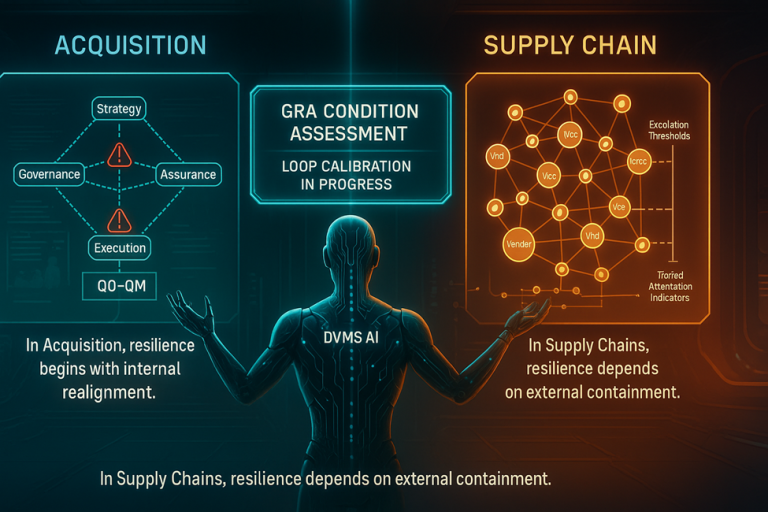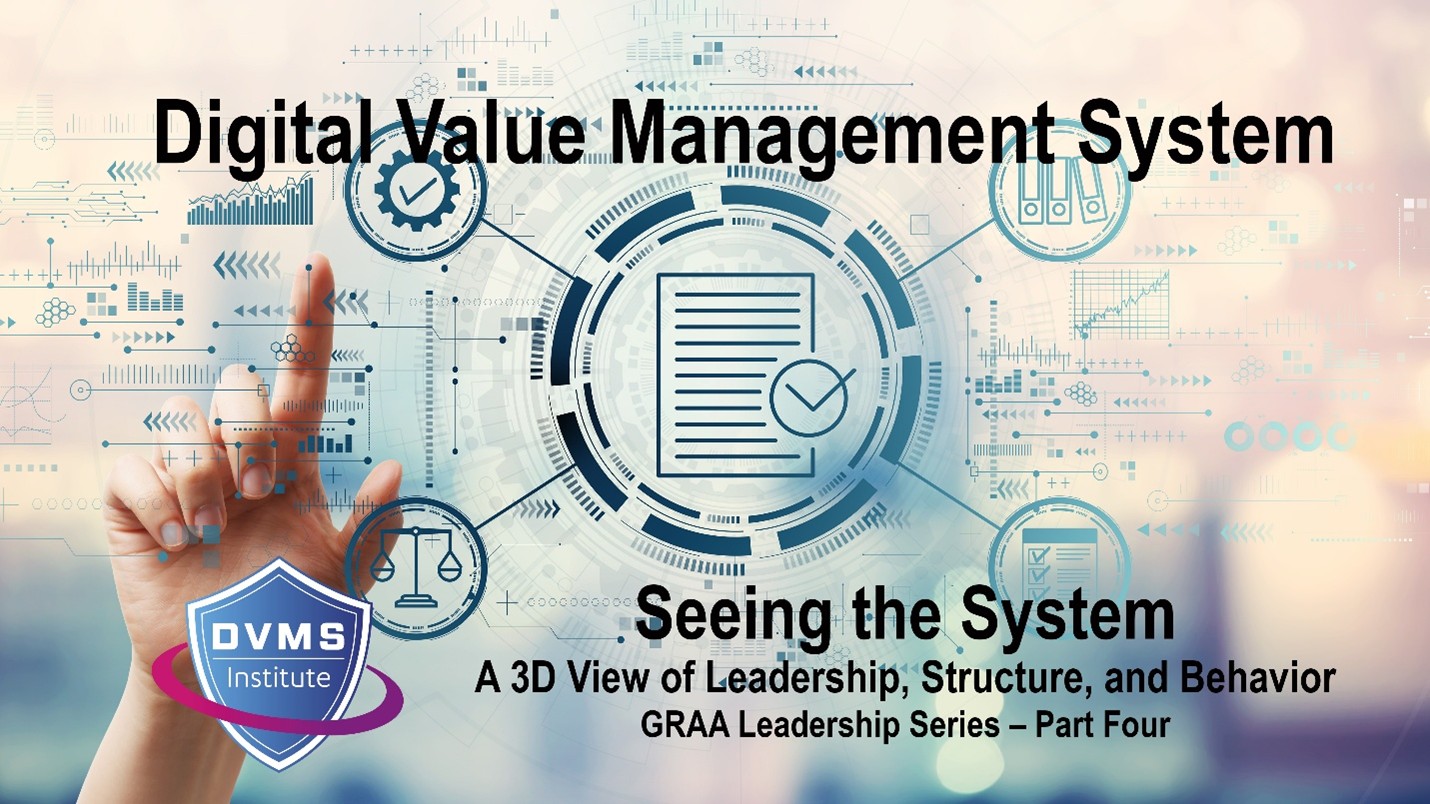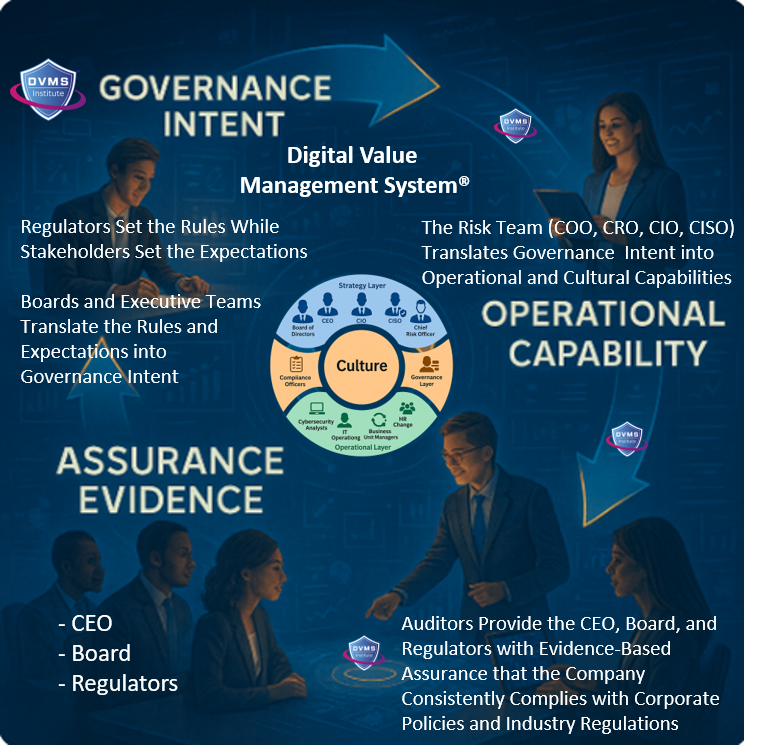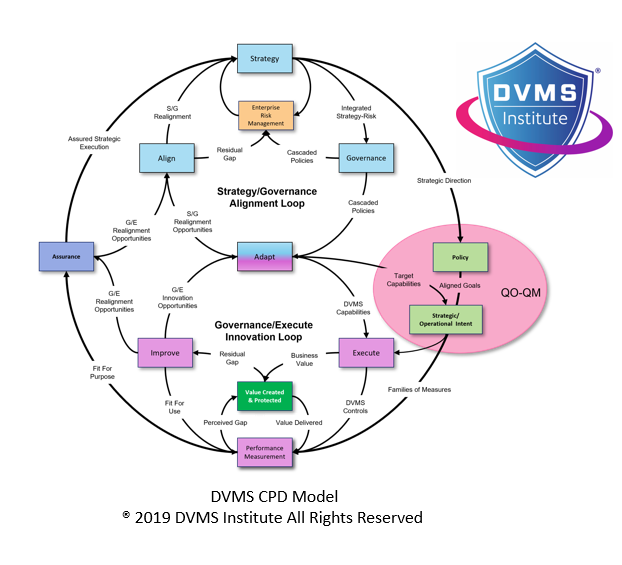How the DVMS Governance Overlay Helps Contextualize Governance-Resilience-Assurance (GRA) in Structurally Different Systems
David Nichols – Co-Founder and Executive Director of the DVMS Institute
Summary
Governance-Resilience Assurance (GRA) isn’t a checklist—it’s an organizational condition that must be designed, measured, and maintained like any other strategic capability.
But here’s the catch: Not all systems behave the same.
The terrain is different whether acquiring a business or managing an extended supply chain. So, your governance strategy and how you detect resilience and deliver assurance must adapt.
This article explores how to operationalize GRA through the Digital Value Management System (DVMS) and its governance overlay, contrasting how GRA behaves in the contexts of acquisitions and supply chains. The goal? To build resilient systems that can think, respond, and evolve under pressure.
The Illusion of One System
As an executive, you’ve probably seen this play out before, so let’s set the scene.
You just acquired a data analytics firm known for rapid innovation. Six weeks in, your security lead flags a surprise: they’ve been pushing unscanned code from an unmonitored GitHub repo to a live product environment. Governance protocols weren’t ignored—they were never understood.
Elsewhere in your operation, a different issue lights off.
A long-standing vendor issues an unannounced software update. The update introduces a conflict with your access control logic, disrupting internal operations. You assumed their controls matched your baseline, but no one ever validated it.
Same resilience categories. Different causes. Same oversight function. Two completely different system dynamics.
And here’s where most governance models fall apart. They assume governance is universal when, in fact, it’s contextual.
GRA: It’s Not a Process. It’s a Condition.
Let’s reframe the acronym.
Governance isn’t a committee.
Resilience isn’t a risk register.
Assurance isn’t a report.
Together, they represent a system’s ability to understand itself, detect misalignment between what’s intended and happening, and take corrective action without waiting for a quarterly audit. In other words, GRA is dynamic.
In the DVMS, GRA is an emergent property when three core feedback loops function with clarity and transparency:
- Strategy ↔ Governance: Aligns vision with executable policy.
- Governance ↔ Assurance: Validates that actions match commitments.
- Governance ↔ Execution: Ensures policy translates into real-world behavior.
GRA is what happens when these loops are tuned and trustworthy, and when the culture supports transparency, adaptation, and resilience.
So, what does this look like in practice?
Let’s explore two scenarios where GRA is mission-critical but plays out differently.
In Acquisitions: GRA Is About Internal Realignment
Mergers and acquisitions aren’t just financial transactions. They’re governance integration events.
You’re not just acquiring software and staff—you’re inheriting decisions, mental models, assumptions, and often, bad habits. That inheritance isn’t always visible on the balance sheet, but it’s deeply embedded in the acquired team’s workflows, norms, and priorities.
Common GRA Friction Points:
- Unverified legacy controls: You assume they’ve patched. They assume they don’t need to.
- Divergent risk tolerances: You manage resilience like a global bank. They’re used to startup speed.
- Assurance as assumption: They claim to follow the policy. You never instrumented the loop to confirm.
The DVMS Response:
- Activate the Strategy ↔ Governance loop. Your first task isn’t compliance—it’s alignment.
- Use Minimum Viable Capabilities (MVCs) to assess inherited functions. What’s there? What’s missing? What’s invisible?
- Deploy DVMS as a governance overlay to reinterpret policy and reestablish decision rights.
- Instrument the loop: Connect policy to behavior and escalate deviations rapidly.
Composite Example: A regional bank acquires a financial technology startup. On paper, the startup’s platform meets all control criteria. However, a post-acquisition review reveals that private key management was ad hoc while encryption protocols were documented. GRA failed—not due to the absence of tools but due to a broken strategy–governance loop. The bank assigned a Governance Lead to embed with the acquired team, operationalized QO–QM, and rebuilt assurance from the inside out.
This is not just a cleanup. It’s realignment of intent with capability, using governance as a translational function, not an enforcement mechanism.
In the Supply Chain: GRA Is About External Containment
Supply chains are structurally different. You’re not realigning a system—you’re relying on someone else’s system. This makes traditional governance models, designed for internal alignment, deeply inadequate for third-party resilience. You don’t own the controls. You don’t control the culture. But you’re on the hook when things break.
Common GRA Friction Points:
- Invisibility into vendor systems: You govern with a flashlight, not a floodlight.
- Performative assurance: You get a SOC 2 report. It’s six months old and templated.
- One-size-fits-none governance language: Your baseline doesn’t map to their reality.
The DVMS Response:
- Shift focus to the Governance ↔ Assurance loop.
- Don’t treat all vendors equally. Use resilience-tiering and capability segmentation to define assurance expectations.
- Design feedback-driven contracts, where indicators and escalation paths are pre-agreed.
- Embed assurance triggers into the supply chain lifecycle—don’t just review once a year.
Real-World Parallel: The infamous 2013 Target breach stemmed from a third-party HVAC vendor with compromised access credentials. The vendor wasn’t a security risk—until they were. GRA failed not because of a lack of governance artifacts but because the assurance loop was nonfunctional. DVMS would treat the vendor as part of a distributed governance ecosystem, not just a signer on an agreement.
In supply chains, governance isn’t enforcement—it’s loop instrumentation across structural boundaries.
Side-by-Side: Different Systems, Different Solutions
| Dimension | Acquisition | Supply Chain |
| Primary DVMS Loop | Strategy ↔ Governance | Governance ↔ Assurance |
| Cultural Leverage | High (internal teams) | Low (external partners) |
| Control Design | Structural integration | Contractual abstraction |
| Risk Type | Inherited and latent | Indirect and opaque |
| Assurance Model | Embedded oversight + QO–QM | Tiered attestation + escalation |
What They Share: Feedback, Not Forms
Despite their structural differences, both environments depend on the same governance fundamentals:
- Cultural modeling: The Z-axis of the 3D Knowledge Model helps you diagnose how culture enables or constrains feedback.
- Instrumented loops: Without systems that sense, transmit, and escalate, you just hope your policies are enough.
- Governance overlays provide the contextual framing and loop calibration needed to manage friction across organizational or structural boundaries.
Whether you’re integrating an acquired team or validating a vendor’s hygiene, GRA doesn’t come from a policy. It comes from loop discipline.
Closing Reflection: Design for GRA, Don’t Declare It
Let’s be blunt, it’s your monkey whether you own the circus or not.
GRA is not a function. It’s a condition that only emerges when strategy, policy, behavior, and culture are in continuous conversation. And that conversation is different in different systems.
- In acquisitions, GRA is about regaining control by rebuilding loops that collapsed during the handoff.
- In supply chains, GRA creates visibility where there is none by designing assurance that travels with the resilience.
Ultimately, a resilient organization isn’t the one that avoids chaos.
It’s the one that transforms chaos into learning—loop by loop, system by system.
So here’s the question before your next acquisition or renewal of that vendor contract: “Have we designed a system that can see itself and respond faster than the risk it absorbs?”
That’s not compliance, that’s governance that works.
About the Author

Dave is the Executive Director of the DVMS Institute.
Dave spent his “formative years” on US Navy submarines. There, he learned complex systems, functioning in high-performance teams, and what it takes to be an exceptional leader. He took those skills into civilian life and built a successful career leading high-performance teams in software development and information service delivery.
The DVMS Institute’s NIST Cybersecurity Framework Digital Value Management System® certified training programs teach enterprises the skills to build a Holistic, Adaptive, and Culture-Powered Overlay System for Cyber Operations Governance, Resilience, and Assurance (GRA).
The NIST-CSF-DVMS positions cyber operations resilience not as a technical function but as a strategic, enterprise-wide capability that mandates engagement from top Leadership to Frontline Employees, trained to proactively identify, classify, and mitigate the systemic cyber risks that impact cyber business operations.
Enabling cyber operations resilience requires a coordinated effort across an organization’s Strategy, Governance, and Operational business layers. When each layer is aligned and operating cohesively as an integrated and adaptive governance system, enterprises can proactively protect the performance and resilience of their cyber business operations.
This unique and innovative approach to Adaptive Governance, Resilience, and Assurance (GRA) enables enterprises to comply with any government-mandated cyber regulation (SEC, DORA, NIS2 etc.) or maturity model program (SCF, HITRUST, CMMC etc.).
® DVMS Institute 2025 All Rights Reserved




